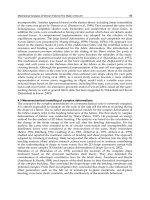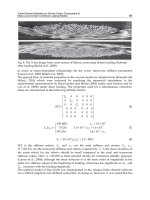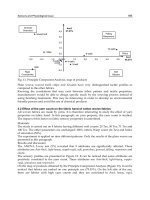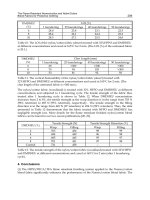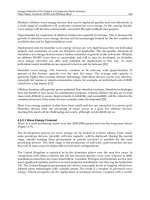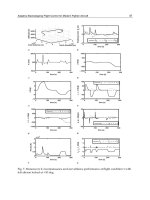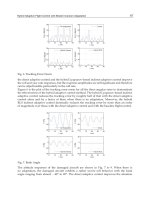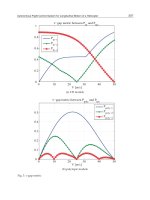Advances in Gas Turbine Technology Part 5 potx
Bạn đang xem bản rút gọn của tài liệu. Xem và tải ngay bản đầy đủ của tài liệu tại đây (2 MB, 30 trang )
Flexible Micro Gas Turbine Rig for Tests on Advanced Energy Systems
109
are often missing or confidential. The following paragraph shows an example of this kind of
validation activities focusing the attention on the machine recuperator.
9.1 Test example: The recuperator model
This validation activity regards the primary-surface (cube geometry) recuperator located
inside the power case of the Turbec T100 machine (Turbec, 2002). So, a recuperator real-
time model was tested against experimental data not in a heat exchanger test rig, but in a
real operative configuration, working in a commercial recuperated 100 kWe machine. The
recuperator model adopts the lumped-volume approach (Ferrari et al., 2005) for both hot
and cold flows. Since momentum equation generates negligible contribution during long-
time transients, because it produces quite fast effects (dynamic effects) that are negligible
in a component with average flow velocities at around 10 m/s, it is possible to properly
represent the transient behaviour of the heat exchanger just using the unsteady form of
the energy equation (the actual governing equation (Ghigliazza et al., 2009a) of the
system).
The finite difference mathematical scheme (shown in Fig. 18) is based on a recuperator
division into four main parts (j = 0, 1, 2, 3). The internal grid is “staggered” to model the
heat exchange between each solid cell (j = 1, 3) and the average temperature of the flow (j =
0, 2): M+1 faces correspond to M cells. The resulting quasi-2-D approach is considered a
good compromise between accuracy of results and calculation effort. The heat loss to
environment and the longitudinal conductivity into solid parts are also included. All the
equations and the integration approach of this model are described in (Ghigliazza et al.,
2009a). Moreover, this paper reports the main data used for the recuperator model (Table 3)
for the results reported here.
Fig. 18. Real-time model: finite difference scheme.
Figure 19 shows the comparison between experimental data and model results related to
recuperator outlet temperature (cold side). The test considered here is a machine start-up
phase carried out from cold condition. The results obtained during this test are acceptable,
even if same margin of improvement exists. With reference to Fig. 19, the following aspects
can be highlighted:
∆
x
q
1
q
3
q
2
q
4
q
5
q
0
q
1
q
4
Tamb
j=3
j=2
j=1
j=0
λ3
λ0
S
0
, h
0
S
1
, h
1
S
2
, h
2
S
3
, h
3
T
2i
T
2,i+1
T
0i
T
0,i+1
0i-1ii+1N
M
Advances in Gas Turbine Technology
110
Measured temperature –
cold side outlet
(
TRC2
)
Calculated temperature –
cold side outlet (TRC2)
Measured values
Calculated values
Fig. 19. Recuperator model validation (start-up phase): cold side outlet.
Thermal capacitance 226.05 [kJ/K]
Convective heat exchange (cold side) 500 [W/m
2
K]
Convective heat exchange (hot side) 250 [W/m
2
K]
Length 0.35 [m]
Nominal pressure drop (cold side) 0.06 [bar]
Nominal pressure drop (hot side) 0.06 [bar]
Table 3. Recuperator model data.
the matching between measured data and model predictions is within a difference of
50°C, which can be considered a good result considering real-time simulation
performance;
measurements show a longer thermal delay (likely explanation: effect due to thermal
shield of thermocouples).
10. Conclusion
A new test rig based on micro gas turbine technology was developed at the TPG laboratory
(campus located at Savona) of the University of Genoa, Italy. It is based on the coupling of
different equipments to study advanced cycles from experimental point of view and to
provide students with a wide access to energy system technology. Particular attention is
devoted on tests related on hybrid systems based on high temperature fuel cells. The main
experimental facilities developed and built for both student and researcher activities are:
A commercial recuperated micro gas turbine (100 kW nominal electrical load) equipped
with a hot water co-generation unit and with the essential instrumentation for control
reasons and to operate typical tests (start-up, shutdown, load changes) on the machine.
A set of external pipes connected to the machine for the flow measurement and
management. These pipes are used to measure with enough accuracy all the properties
necessary for cycle characterization (e.g. the air mass flow rate or recuperator boundary
Flexible Micro Gas Turbine Rig for Tests on Advanced Energy Systems
111
temperatures), not available in the machine commercial layout. In particular the chapter
shows a test example related to the compressor map measuring.
An external modular vessel to test the coupling of the machine with different additional
innovative cycle components, such as saturators, fuel cells of different layouts or
technology, or additional heat exchangers.
Additional devices for hybrid system emulation activities. This part describes the
anodic recirculation based on a single stage ejector (coupled to the rig for tests related to
the anodic/cathodic side interaction), the steam injection system based on a 120 kW
steam generator (used to emulate the turbine inlet composition typical of a hybrid
system), and a real-time model used to emulate the components not physically present
in the rig (e.g. the fuel cell). As an example of tests carried out with these devices, this
chapter reports the main results obtained during fuel and current steps carried out with
the real-time model coupled with the rig.
Compressor inlet temperature control devices (heat exchangers, pipes, pump, and
control system) to evaluate performance variations related to ambient temperature
changes. Particular attention is focused on tests carried out on the recuperator with the
machine operating in grid-connected conditions.
An absorber unit connected to the plant (the hot water generated by the WHEx is used
as primary energy to produce cold water) to carry out tests at compressor inlet
temperature values under 20°C and to study tri-generative configurations.
Great attention is devoted to validation activities for time-dependent simulation
models. As an example, this chapter shows the comparison between experimental data
and model results related to recuperator outlet temperature (cold side), during a cold
start-up phase.
Besides the additional developments and tests on the rig, already planned and presented in
(Pascenti et al, 2007; Ferrari et al., 2009a; Ferrari et al., 2010c; Prando et al., 2010), all the
different layout configurations will be considered for tests. For instance, in an ongoing work
it is planned to use the real-time model for control system development activities related on
SOFC hybrid plants and the absorber cooler to carry out tests at lower ambient temperature
conditions, also considering tri-generative configurations.
11. Acknowledgment
This test rig was mainly funded by FELICITAS European Integrated contract (TIP4-CT-2005-
516270), coordinated by Fraunhofer Institute, by LARGE-SOFC European Integrated Project
(No. 019739), coordinated by VTT, and by a FISR National contract, coordinated by Prof.
Aristide F. Massardo of the University of Genoa.
The authors would like to thank Prof. Aristide F. Massardo (TPG Coordinator) for his
essential scientific support, Dr. Loredana Magistri, (permanent researcher at TPG) for her
activities in design point definition, and Mr. Alberto N. Traverso (associate researcher at
TPG) for his technological support on absorption cooler installation.
12. References
Kolanowski, B. F. (2004). Guide to Microturbines, Fairmont Press, ISBN 0824740017, Lilburn,
Georgia (USA).
Advances in Gas Turbine Technology
112
Boyce, M. P. (2010). Handbook for Cogeneration and Combined Cycle Power Plants, Second
Edition, ASME Press, ISBN 9780791859537, New York, New York (USA).
Massardo, A. F., McDonald, C. F., & Korakianitis, T. (2002). Microturbine-Fuel Cell Coupling
for High-Efficiency Electrical-Power Generation. Journal of Engineering for Gas
Turbines and Power, Vol. 124(1), pp. 110-116, ISSN 0742-4795.
Lindquist, T., Thern, M., Torisson, T. (2002). Experimental and Theoretical Results of a
Humidification Tower in an Evaporative Gas Turbine Cycle Power Plant.
Proceedings of ASME Turbo Expo 2002, 2002-GT-30127, ISBN 0791836010,
Amsterdam, The Netherlands, June 3-6, 2002.
Traverso, A., Massardo, A. F., Scarpellini, R. (2006). Externally Fired micro-Gas Turbine:
Modelling and Experimental Performance.
Applied Thermal Engineering, Elsevier
Science, Vol. 26, pp. 1935-1941, ISSN 1359-4311.
Magistri, L., Costamagna, P., Massardo, A. F., Rodgers, C., McDonald, C. F. (2002). A Hybrid
System Based on a Personal Turbine (5 kW) and a Solid Oxide Fuel Cell Stack: A
Flexible and High Efficiency Energy Concept for the Distributed Power Market,
Journal of Engineering for Gas Turbines and Power, Vol. 124, pp. 850-875, ISSN: 0742-
4795, New York, New York (USA).
Magistri, L., Traverso, A., Cerutti, F., Bozzolo, M., Costamagna, P., Massardo, A. F. (2005).
Modelling of Pressurised Hybrid Systems Based on Integrated Planar Solid Oxide
Fuel Cell (IP-SOFC) Technology.
Fuel Cells, Topical Issue “Modelling of Fuel Cell
Systems”, WILEY-VCH, Vol. 1, Issue 5, ISSN 1615-6854.
Pedemonte, A. A., Traverso, A., Massardo, A. F. (2007). Experimental Analysis of
Pressurised Humidification Tower For Humid Air Gas Turbine Cycles. Part A:
Experimental Campaign.
Applied Thermal Engineering, Elsevier Science, Vol. 28, pp.
1711–1725, ISSN 1359-4311.
McDonald, C. F. (2003). Recuperator Considerations For Future High Efficiency
Microturbines.
Applied Thermal Energy, Elsevier Science, Vol. 23, pp. 1453-1487,
ISSN 1359-4311.
Ferrari, M. L. (2011). Solid Oxide Fuel Cell Hybrid System: Control Strategy for Stand-Alone
Configurations.
Journal of Power Sources, Elsevier, Vol. 196, Issue 5, pp. 2682-2690,
ISSN: 0378-7753
.
Tucker, D., Liese, E., Gemmen, R. (2009). Determination of the Operating Envelope for a
Direct Fired Fuel Cell Turbine Hybrid Using Hardware Based Simulation.
Proceedings of International Colloquium on Environmentally Preferred Advanced Power
Generation
2009, ICEPAG2009-1021, ISBN 3-7667-1662-X, Newport Beach, California,
USA
.
Hohloch, M., Widenhorn, A., Lebküchner, D., Panne, T., Aigner, M. (2008). Micro Gas
Turbine Test Rig for Hybrid Power Plant Application.
Proceedings of ASME Turbo
Expo 2008, GT2008-50443, ISBN 0791838242, Berlin, Germany.
Ferrari, M. L., Pascenti, M., Bertone, R., Magistri, L. (2009a). Hybrid Simulation Facility
Based on Commercial 100 kWe Micro Gas Turbine.
Journal of Fuel Cell Science and
Technology
, Vol. 6, pp. 031008_1-8, ISSN: 1550-624X, New York, New York (USA).
Ferrari, M. L., Pascenti, M., Magistri, L., Massardo, A. F.
(2010a). Hybrid System Test Rig:
Start-up and Shutdown Physical Emulation
, Journal of Fuel Cell Science and
Technology
, Vol. 7, pp. 021005_1-7, ISSN: 1550-624X, New York, New York (USA).
Flexible Micro Gas Turbine Rig for Tests on Advanced Energy Systems
113
Ferrari, M. L., Pascenti, M., Magistri, L., Massardo, A. F. (2010b). Analysis of the Interaction
Between Cathode and Anode Sides With a Hybrid System Emulator Test Rig,
Proceedings of International Colloquium on Environmentally Preferred Advanced Power
Generation
2010, ICEPAG2010-3435, Costa Mesa, CA (USA).
Turbec T100 Series 3 (2002). Installation Handbook.
Pascenti, M., Ferrari, M. L., Magistri, L., Massardo, A. F. (2007). Micro Gas Turbine Based
Test Rig for Hybrid System Emulation,
Proceedings of ASME Turbo Expo 2007,
GT2007-27075, ISBN: 0791837963, Montreal, Canada.
Traverso, A. (2005). TRANSEO Code for the Dynamic Performance Simulation of Micro Gas
Turbine Cycles,
Proceedings of ASME Turbo Expo 2005, GT2005-68101, ISBN:
0791846997, Reno, Nevada (USA).
Traverso, A., Calzolari, F., Massardo, A. F. (2005). Transient Behavior of and Control System
for Micro Gas Turbine Advanced Cycles,
Journal of Engineering for Gas Turbine and
Power, Vol. 127, pp. 340-347, ISSN: 0742-4795, New York, New York (USA).
Ferrari, M. L., Liese, E., Tucker, D., Lawson, L., Traverso, A., Massardo, A. F. (2007).
Transient Modeling of the NETL Hybrid Fuel Cell/Gas Turbine Facility and
Experimental Validation,
Journal of Engineering for Gas Turbines and Power, Vol. 129,
pp. 1012-1019, ISSN: 0742-4795, New York, New York (USA).
Caratozzolo, F., Traverso, A., Massardo, A. F. (2010).Development and Experimental
Validation of a Modelling Tool for Humid Air Turbine Saturators,
Proceedings of
ASME Turbo Expo 2010, ASME Paper GT2010-23338, ISBN: 9780791838723,
Glasgow, UK.
Bagnasco, M. (2011). Emulation of SOFC Hybrid System With Experimental Test Rig and
Real-Time Model, Bachelor Thesis, TPG, Genova, Italy (in Italian).
Ferrari, M. L., Pascenti, M., Traverso, A. N., Massardo, A. F. (2011). Hybrid System Test Rig:
Chemical Composition Emulation With Steam Injection,
Proceedings of International
Conference on Applied Energy
, pp. 2821-2832, Perugia, Italy.
Ferrari, M. L., Bernardi, D., Massardo, A. F. (2006). Design and Testing of Ejectors for High
Temperature Fuel Cell Hybrid Systems,
Journal of Fuel Cell Science and Technology,
Vol. 3, pp. 284-291, ISSN: 1550-624X, New York, New York (USA).
Massardo, A. F., Magistri, L. (2003). Internal Reforming Solid Oxide Fuel Cell Gas Turbine
Combined Cycles (IRSOFC-GT) – Part II: Energy and Thermoeconomic Analyses,
Journal of Engineering for Gas Turbines and Power, Vol. 125, pp. 67-74, ISSN: 0742-
4795, New York, New York (USA).
Ferrari, M. L., Pascenti, M., Magistri, L., Massardo, A. F., (2009b). Hybrid System Emulator
Enhancement: Anodic Circuit Design,
Proceedings of International Colloquium on
Environmentally Preferred Advanced Power Generation 2009
, ICEPAG2009-1041,
Newport Beach, California, USA.
Ghigliazza, F., Traverso, A., Pascenti, M., Massardo, A. F. (2009a). Micro Gas Turbine Real-
Time Modeling: Test Rig Verification”,
Proceedings of ASME Turbo Expo 2009,
GT2009-59124, Orlando, Florida (USA).
Ghigliazza, F., Traverso, A., Massardo, A. F., Wingate, J., Ferrari, M. L. (2009b). Generic
Real-Time Modeling of Solid Oxide Fuel Cell Hybrid Systems,
Journal of Fuel Cell
Science and Technology, Vol. 6, pp. 021312_1-7, ISSN: 1550-624X, New York, New
York (USA).
Advances in Gas Turbine Technology
114
Ferrari, M. L., Pascenti, M., Magistri, L., Massardo, A. F. (2010c), Micro Gas Turbine
Recuperator: Steady-State and Transient Experimental Investigation
, Journal of
Engineering for Gas Turbines and Power
, Vol. 132, pp. 022301_1-8, ISSN: 0742-4795,
New York, New York (USA).
Prando, A., Poloni, M. (2010). Absorber Tri-generative System Based on a 100 kWe Micro
Gas Turbine: Study and Plant Development, Bachelor Thesis, TPG, Genova, Italy
(in Italian).
Ferrari, M. L., Traverso, A., Magistri, L., Massardo, A. F. (2005). Influence of the Anodic
Recirculation Transient Behaviour on the SOFC Hybrid System Performance,
Journal of Power Sources, Elsevier, Vol. 149, pp. 22-32, ISSN: 0378-7753.
6
Biofuel and Gas Turbine Engines
Marco Antônio Rosa do Nascimento and Eraldo Cruz dos Santos
Federal University of Itajubá – UNIFEI
Brazil
1. Introduction
Currently, the interest in using vegetable oils and their derivatives as fuel in primary
drives for the generation of electricity has increased due to rising oil prices and concerns
over the environmental impacts caused by fossil fuel use. For viability of using biodiesel
as a substitute for fossil fuels for power generation, should be considered the emissions of
greenhouse gases, i.e., pollutants such as nitrogen oxides (NO
X
), sulfur oxides (SO
X
),
carbon monoxide (CO) and particulates into the atmosphere during the lifetime of the
power plant.
According HABIB (2010) the effect of using petroleum-derived fuel in aviation on the
environment is significant. Given the intensity of air traffic and civil and military operations,
making the development of alternative fuels for the aviation sector is justified, necessary
and critical.
Another concern that must be considered is the quality of biofuel to be stored over time, this
being an obstacle to be overcome in order to maintain fuel quality and operational reliability
of gas turbine installations operating with biofuels.
Biofuels also have the advantage of being renewable and cleaner, this is due in large part
because they do not contain sulfur in its composition. The use of distributed generation
renewable fuels can be advantageous in isolated regions, far from major urban centers, to
generate electricity using the resources available on site.
Among other engines, gas turbines represent one of the technologies of distributed
generation, which is characterized by the supply of electricity and heat simultaneously. In
principle these machines should operate without major problems by using biofuels, because
of similarities with the characteristics of the fuels conventionally used. However, there are
few references on the performance of gas turbines operating on biofuels and this is the
motivation of this study.
Microturbines are small gas-turbo generators designed to operate in the power range from
10 to 350 kW. Although its operation will also be based on the Brayton cycle, they present
their own characteristics that differentiate them from large turbines.
Most gas turbine available today, originated in the military and aerospace industry. Many
projects were aimed at applications in the automotive sector in the period between 1950 and
1970. The first gas turbine generation was developed from turbo aircraft, buses and other
commercial means of transport (SCOTT, 2000). Interest in stationary generation market has
expanded in the years 1980 and 1990, and its use in distributed generation has been
accelerated (LISS, 1999).
Advances in Gas Turbine Technology
116
It is hoped that in future gas turbines of small power is an alternative for power generation
for residential and commercial segment, since the operational reliability is one of the main
needs in these sectors (WILLIS and SCOTT, 2000). These turbines have various applications
such as power generation in the place of consumption (on-site), the uninterrupted supply of
electricity, to cover peak loads, cogeneration and mechanical drive, which characterizes the
distributed generation (BIASI, 1998).
Gas turbines may use different types of fuel such as diesel, kerosene, ethanol, natural gas
and gas obtained from biomass gasification, etc. The shift to gas from biomass has been
considered promising, but some changes must be made in supply and combustion systems
turbine, aiming to modify the injection and control systems and the volume of the
combustion chamber.
The scope of this chapter includes a brief description of the systems of gas turbines, reports
the experiences of biofuel use in gas turbines made until today, with emphasis on the
experience developed in the Laboratory of Gas Turbines and Gasification the Institute of
Mechanical Engineering, Federal University of Itajubá - IEM/UNIFEI aspects of thermal
performance and emissions of gases from gas turbines of small power.
2. Biofuels
Biofuels are fuels of biological origin, i.e., not fossil. They are produced from plants such as
corn, soy, sugar cane, castor beans, sugar beet, palm oil, canola, babassu oil, hemp, among
others. Organic waste can also be used for the production of biofuel. The main biofuels are
ethanol (produced from sugar cane and corn), biogas (biomass), bioethanol, biodiesel (from
palm oil or soy), among others.
Biofuels can be used on vehicles (cars, trucks, tractors, etc.), turbines, boilers, etc , in whole
or blended with fossil fuels. In Brazil, for example, soy biodiesel is blended with fossil
diesel. Is also added to gasoline the ethanol produced from sugar cane.
The advantage of using biofuels is the significant reduction of greenhouse gas emissions. It
is also advantageous because it is a renewable source of energy instead of fossil fuels (diesel,
gasoline, kerosene, coal).
This section will describe some characteristics and requirements of biofuels that have
potential for use in gas turbines.
2.1 Gas turbines operating on liquid fuels
Biofuels have the greatest potential for use in gas turbines are biodiesel and ethanol, due to
factors such as availability physical-chemical characteristics similar to fossil fuels such as
diesel or jet fuel. Table 1 presents a summary of requirement of liquid fuel as defined by the
manufacturers of gas turbines for efficient operations (BOYCE, 2006).
Moisture and sediment 1.0 % (v%) maximum
Viscosity 20 cS at injector
Dew-Point 20 °C at ambient temperature
Carbon Residue 1.0 % (p.) maximum
Hydrogen 11% (p.) maximum
Sulfur 1% (p.) maximum
Table 1. Requirements liquid fuel for gas turbines.
Biofuel and Gas Turbine Engines
117
The growing interest in biofuels along with increasing market demand for generators
supplied by renewable fuels has led manufacturers to modify the designs of gas turbines
and micro-turbines, in order that they can operate on biofuels.
For biodiesel, the supply system is being modified to fit this new biofuel due to some
reasons such as higher viscosity, content of acylglycerols and the effects of corrosion. New
corrosion-resistant materials, systems control the flow of fuel and improved geometry
optimized for the guns are some of the challenges of these new projects.
In scientific literature there is little information about testing of gas turbines for small
power, operating on biofuels. To study the impact of biofuel use in the operation and
maintenance of gas turbine, one must take the following measures:
Define the physical and chemical characteristics of both diesel and biofuel used in the
tests. Some important characteristics are: density, distillation, viscosity, ash content,
phosphorus, iodine and sulfur, water content, cetane number, oxidation stability,
flashpoint, freezing point, dew point, volumetric composition of methyl, ethyl and
lipids, glycerol, lower calorific value, etc. These values should be compared with the
requirements of the standards on diesel and biodiesel to demonstrate that they can be
used in the study.
Once further tests it is possible to define what characteristics of biodiesel are relevant to
the determination of changes in engine behavior, considering the performance
parameters and emissions. The higher viscosity of biodiesel can lead to difficulties in its
injection into the combustion chamber. It is possible reduce the viscosity of the mixture
increases its temperature, or by adding alcohol. The lower the flash point of biodiesel
could also cause problems in combustion.
It is possible find accumulation of carbonized material in the inner parts of the gas
turbine, after the tests with biodiesel. The biofuel can produce corrosion in fuel supply
system.
It is also recommended to install a filter at least 50 μm at the fuel supply in the gas
turbine when using biodiesel.
It is not advisable to use biofuels in gas turbines without performing a preliminary
economic analysis.
Some alternative liquid fuels such as vegetable oil, biodiesel or pyrolysis oil, ethanol and
methanol are being tested in gas turbines (GÖKALP, 2004).
As biodiesel has similar properties to diesel, it can be used directly in a gas turbine, blended
with diesel in various proportions (usually uses 5 to 30% biodiesel in the blend with diesel).
The properties of biodiesel are slightly different to those of diesel in terms of energy content
or physical properties.
The Lower Heating Value (LHV) of liquid biofuels such as pure biodiesel (B100), B5 B30 and
vegetable oils are between 37,500 and 44,500 kJ/kg, which is close to regular diesel
(GÖKALP, 2004).
The viscosities of ethanol, biodiesel and its blends with diesel are lower than the residual oil
from the kitchen, making it easier to spray. Vegetable oils and oils derived from pyrolysis
have a very high viscosity, which causes problems in its mist inside the combustion
chamber of gas turbines. However, these fuels can be heated to reduce its viscosity before
being injected into the combustor.
Fuel oil resulting from pyrolysis of wood, vegetable oils and methyl esters has a
carbon/hydrogen rate (C/H) higher than that of conventional diesel. As consequence, there
Advances in Gas Turbine Technology
118
may be an accumulation of soot inside the combustion chamber or turbine blades
(GÖKALP, 2004). Another factor that changes as a result of this feature is the transfer of heat
by radiation from the flame to the flame tube.
2.2 Gas turbines operating on gaseous fuels
Thermal power plants with gas turbines operating with gas from biomass need to present
efficient, simple technology, low cost and operational reliability, in order that these plants
could become economically competitive with traditional systems of power generation, such
as stationary alternative engines.
The potential of gas turbines for this application is great, although the gas must be subjected
to cleaning to remove solid impurities and/or gas that can damage some components of
some systems of gas turbine.
Gaseous fuels can be obtained by gasification of biomass, which in addition to the gas
generates a set of substances, such as tar which is a compound in gaseous form in the fuel
gas, which has an appreciable calorific value, although it shows a tar obstacle to the use of
gaseous fuels in internal combustion engines, due to its high corrosive power of components
and reduced engine efficiency.
In the case of gas turbines, the tar can be a problem only happens when its condensation.
Basically there are two strategies to address the problem of tar, remove it from the fuel gas
or burn it in the combustion chamber. In the first case, nickel-based catalysts have shown
very promising results. In the second case, the strategy is to keep the fuel temperature above
the dew point of tar in the gas supply pipes, and perform your burning at high temperature
in the combustion chamber (SCHMITZ, 2000).
Currently, gas turbines are designed for a specific fuel (natural gas or fuel oil). Recent
progress has been achieved in the methodologies and tools for the design of combustors for
gas turbine. It is possible to perform a clean combustion of fossil fuels by employing low-
carbon technologies based on premixed combustion.
There are ongoing projects that aim to harness these advances for applications geared to a
wider range of fuels with commercial potential, including those with low calorific value,
obtained from biomass gasification. Some procedures should be established for selecting
appropriate fuels to be used taking into account the performance of combustion and
emissions of soot and NO
X
. Furthermore, it should be considered the adaptability of existing
burners to use alternative fuels selected (GÖKALP, 2004).
Some gaseous alternative fuels also have potential for use in gas turbines, for example, the
synthesis gas from gasification of biomass, the biomass pyrolysis gas, gas from digesters
(biogas) and residual gas from industrial processes, which are rich in hydrogen.
Industrial gases such as methane reformed with steam, refinery gas, residual gas from the
Fischer-Tropsch gasification gas with oxygen gas and slow pyrolysis of wood, have a LHV
comparable to natural gas. This is due to the high hydrogen content of fuel gases, which lies
between 19 and 45% of the volume. Rather, the LHV of gas gasification with air and biogas
are very low because they are produced at atmospheric pressure, so they must be
compressed before being used in gas turbines.
Except reformed methane with steam, all other gaseous fuels mentioned above have a C/H
greater than that of natural gas (GÖKALP, 2004).
According BOYCE (2006) in Table 2 presents an overview of the requirements for gaseous
fuels that can be used in gas turbines.
Biofuel and Gas Turbine Engines
119
Calorific 11,184 – 41,000 kJ/m³
Solid Contaminants < 30 ppm
Flammability Limits 2.2 : 1
Content of sulfur, sodium, potassium and lithium
< 5 ppm
(In the form of meta alkaline sulfate)
H
2
O (p.) < 25%
Table 2. Requirements gaseous fuel for gas turbines.
According KEHLHOFER (2009) the type and composition of the fuel has a direct influence
on efficiency and emission of gases from a gas turbine. The LHV of the fuel is important
because it defines the mass flow of fuel and consequently its specific consumption. The fuel
composition is also important as it influences the performance of the cycle because it
determines the enthalpy of gas entering the turbine, and the available enthalpy drop off the
engine and the amount of steam generated in the recovery boiler.
2.3 Clean fuel gas
Gaseous fuels obtained through the processes of gasification and pyrolysis produce fuels
with low-and medium calorific value. According to Table 1, in some gas turbines require a
minimum value for the calorific value of gas, which can be difficult to achieve it.
Manufacturers set very strict parameters regarding the quality of the combustible gases to avoid
possible damage to the hot parts of gas turbine. Alkaline components present in the fuel,
especially chlorides cause corrosion at high temperatures. The presence of tar should also be
considered if the operations of fuel valves occur at temperatures below the dew point of the tar.
Almost all biogenic fuels contain considerable amounts of halogens (Cl, F, Br), alkali (Na, K),
alkali oxides and other metals (Zn, Cu, Ca). The sulfur content is usually low. Unless most of
these items may be retained in the gasifier or pyrolysis reactor, the requirements of the fuel gas
cannot be met when employing biomass. The fuel gas contains impurities mentioned in the
gaseous or solid, so it is inevitable that they would perform a deep cleaning of the gas. The
chloride concentration should be considerably reduced. The slow pyrolysis produces gases,
which are characterized by average values of calorific value, situated in the range between
7,000 and 13,000 kJ/kg, and low levels of chlorides and alkalis.
Should be applied under heating rates and moderate temperatures to produce pyrolysis gas
with low alkali chloride. High rates of heating fuel break biogenic structure, which favors
the conversion of solid pyrolysis gas, however, compromises the retention of impurities in
the vegetable coal. High levels of retention in coal are only achieved with low rates of
heating in combination with moderate temperatures.
It is estimated that for slow pyrolysis with a maximum temperature of 350 °C are retained
approximately 86% of chloride, and the calorific value of gas reaches 10.9 MJ/kg, which can
be considered average. These conditions result in a lower ratio chloride/energy in the gas,
although the concentrations required by gas turbines today are even smaller, and therefore,
solid and gaseous impurities must be removed (SCHMITZ, 2000).
3. Experiments with biofuels in gas turbine engines
This item will be described some experiences with the utilization of biofuels in gas turbines.
Testing gas micro-turbines operating with biodiesel were performed by LOPP et. al. (1995);
MIMURA (2003); BIST (2004); SCHMELLEKAMP and DIELMANN (2004); WENDIG (2004)
Advances in Gas Turbine Technology
120
and CORRÊA (2006). LOPP (1995) presented the results of the thermal performance of a gas
turbine using a blend of jet fuel (Jet fuel - JF) and soy biodiesel (B). Three different fuels: JF,
B10/JF90 and B20/JF80. The turbine efficiency reached its nominal value with B20, with a
slightly better performance than with B10. There was an increase in fuel consumption
proportional to the addition of biodiesel in the blend. The blends with biodiesel/diesel fuel
were compatible enough to allow additional testing and show its potential as an alternative
fuel. CO
2
emissions were reduced after the engine was fueled with B20. The two blends B10
and B20 did not show a noticeable increase in emissions of particulate matter compared to
the JF. Subsequent inspections in the combustor and turbine blades showed no deposition or
degradation of components.
MIMURA (2003) conducted a study of performance and emissions from a micro-turbine
supplied with biodiesel from waste food oil regenerated. Operating in cogeneration mode
the system had a thermal efficiency of 64%. It was observed emissions of 6 ppm of CO, 23
ppm of NO
X
and 1.0 ppm of SO
X
.
BIST (2004) performed a feasibility study on the use of methyl esters (biodiesel) derived
from soy oil as additives blended with fuel gas turbine aircraft. Several blends were tested to
identify which would meet the specifications for this type of engine without the need to
change the initial design. Was not noticed a significant increase in fuel consumption for
blends of B2, B5 and B10. In cases of B20 and B30 blends the increase in consumption was
evident, being 7 and 10%, respectively. It was shown that a decrease in the efficiency of
combustion in gas turbine as the percentage of biodiesel in the blend increase. In terms of
emissions, an increase of CO content in the gases, due to the increase in the percentage of
biodiesel in the blend, was noticed what indicates a reduction in combustion efficiency. This
behavior is contrary to that seen in piston engine in which the CO decrease with increasing
content of biodiesel blends.
There was also an increase in emissions of NO by increasing the concentration of biodiesel,
therefore, NO
2
emissions did not change significantly. The high viscosity of biodiesel is a
limiting factor for not testing with larger percentages than B30.
The biodiesel from soybeans contain glycerin. The amount of glycerin in the mixture should
be kept as low as possible to avoid problems in combustion process. These measurements
indicated that the B30 blend showed a content of glycerin which can be considered
negligible. In none of the blends tested has been observed increases in pressure drop
through analysis in the fuel filter and therefore none of them produced sediments that could
cause blockage in the supply system of the turbine engine (BIST, 2004).
SCHMELLEKAMP and DIELMANN (2004) present the results of using vegetable oil from
rape seed in a 30 kW micro-turbine, in blends of 10, 20 and 30%. Fuel consumption
increased with increasing biodiesel blend. Using B30 obtained a 12% higher consumption in
the range of operation. By using B10 it was verified that CO were lower than in the case of
use of fossil diesel. However, when were employed mixtures of B20 and B30 it was observed
a higher level of CO emissions. The viscosity of vegetable oil is much greater than that of
biodiesel, so it is necessary to make a preheating the blend prior to injection.
The results of operating a 75 kW micro-turbine, burning biodiesel from rapeseed, sunflower,
animal fats, were presented by WENDIG (2004). The operation with these three kinds of
methyl esters showed a significant increase in emissions of CO and CO
2
at full load. All
fuels examined showed a reduction in NO
X
emissions in the range of 55%. Were problems
related to the corrosive characteristics of biodiesel.
More recently, tests of performance and emissions in a 30 kW micro-turbine, using biodiesel
from castor beans, were published by CORRÊA (2006). During the tests it was necessary to
Biofuel and Gas Turbine Engines
121
preheat the blends to 40 °C to achieve the viscosity values required by the manufacturer.
The specific fuel consumption increased nearly 21% when using B100. Throughout the
power range studied, it was observed a reduction in emissions of CO and NO
X
in the
exhaust gases.
WENDIG (2004) by using biogas found a decrease in CO with increasing load, reaching 100
ppm at full load. Since the emission of CO
2
was about 45 ppm, constant throughout the
range of operation, and SO
2
emissions decreased. At full load the SO
2
emission was
practically zero. The micro-turbine showed the lowest emission of NO
X
at full load (20
ppm).
The existing reports on the use of biodiesel in micro-turbines describe increases in fuel flow
rate when increasing the proportion of biodiesel in the blend; this is explained in part by
lower LHV of biodiesel compared to diesel.
Problems due to viscosity, corrosion and accumulation of foreign material in the turbine
blades may be in extended operations. These problems can be mitigated through a
rigorous verification of the characteristics of biodiesel, demanding that it complies with
the standards and manufacturers recommendations. In Brazil, ABNT published standards
NBR 15341, NBR 15342, NBR 15343 and NBR 15344, to specify the properties of biodiesel
(ABNT, 2006).
Manufacturers of gas turbines and micro-turbines are currently developing models that can
use biofuels such as biodiesel. The changes that are taking place mainly consist in the use of
materials resistant to corrosion in fuel and injection systems, and develop systems adjusted
to work with injection of fuel physical-chemical characteristics different from diesel.
4. Cycles with potential for use of biofuels
A gas turbine is a set of three components: the compressor, combustion chamber and the
turbine itself. This configuration forms a gas thermodynamic cycle accordance with the
model ideal Brayton cycle is called. This set can operate in an open cycle, with air as the
working fluid, which is admitted to the atmospheric pressure, passes through the turbine
and is discharged back into the atmosphere without returning to the admission.
Thus, despite being an open cycle, some energy from the combustion is rejected in the form
of heat contained in hot exhaust gases. The heat rejection is a physical limit of the gas
turbine, intrinsic to the operation of thermodynamic cycles, even in ideal cases.
The loss of condition ideal cycle in a gas turbine can be quantified by the ratio involving the
calorific value of fuel, discounting the power to drive the compressor and power net. Thus,
decreasing the losses as it reduces the exhaust temperature, and raises the temperature of
turbine inlet. The resistance to high temperature components of gas turbine is a very critical
point in building technology such equipment (COHEN, H. et. al., 1996).
Turbines designed to operate in simple cycle, as shown in Figure 1, in view of the thermal
efficiency of the cycle, have gas outlet temperature reduced to maximum and have
optimized compression ratio. The compression ratio is the ratio between the pressure of air
entering and exiting the compressor. For example, if air enters at 1.0 atm, and leaves the
compressor at 15.0 atm, the compression ratio is 15:1.
Apart from variation of the simple cycle obtained by the addition of these other
components, considerations must be given to two system distinguished by the use of open
(Figure1) and close cycles (Figure 2).
Advances in Gas Turbine Technology
122
Fig. 1. Scheme of a simple cycle gas turbine system.
In the process of closed cycle operation is the same as the open cycle, the difference is that
the working fluid remains within the system and the fuel is burned outside the system.
The biggest advantage of the closed cycle is the possibility of using high pressure
throughout the circuit, which results in reducing the size of the turbomachinery, depending
on power output, and allows the variation of power output by varying the pressure level of
the circuit.
The significant feature is that the hot gases produced in the boiler furnace or reactor core
never reach the turbine; they are merely used indirectly to produce an intermediate fluid,
namely steam.
In order to produce an expansion through a turbine a pressure ratio must be provided and
the first necessary step in the cycle of gas turbine plant must therefore be compression of the
working fluid.
Fig. 2. Scheme of a close cycle gas turbine with a heat exchanger.
If after compression the working fluid was to be expanded directly in the turbine, and there
were no losses in either component, the power developed by the turbine would just equal
that absorbed by the compressor. Thus if the two were coupled together the combination
would do no more than turn itself round. But the power developed by the turbine can be
increased by the addition of energy to raise the temperature of the working fluid prior to
Biofuel and Gas Turbine Engines
123
expansion. When the working fluid is air a very suitable means of doing this is by
combustion of fuel in the air which has been compressed.
One way to increase the thermal efficiency of a closed cycle is the addition of a heat
exchanger; however there are limits to the introduction of this equipment because it can
cause loss of pressure in the circuit.
A cycle gas turbine with a heat exchanger can also be called a regenerative cycle, as shown
in Figure 3, wherein the heat rejected in the exhaust gases of the gas turbine passes through
the heat exchanger and heats the air from the compressor before entering the chamber
combustion. The pre-heated air reduces the fuel consumption injected into the combustion
chamber, increasing the thermal efficiency of the cycle.
Fig. 3. Scheme of a regenerative cycle gas turbine.
Specific gas turbines to operate in combined cycle, as shown in Figure 4, are developed in
order to maximize the thermal efficiency of the cycle as a throughout. Therefore, reducing
the temperature of the exhaust gas is not necessarily the most critical point in terms of
efficiency, since the gas turbine exit are still used to generate power in other equipment.
Fig. 4. Scheme of a combined cycle.
Advances in Gas Turbine Technology
124
Another configuration of installation of gas turbines is the cycle where there is the presence
of an intercooler before or between compressors, i.e., compressors among the low and high
pressure. In this configuration the air that enters into the first compressor is compressed to a
pressure intermediate between the maximum of the cycle and the ambient pressure, as
shown in Figure 5.
Fig. 5. Scheme of a cycle with intercooler.
In the case of plants with two compressors the air leaving the first compressor (low
pressure) enters the intercooler where the heat is removed without major pressure drop.
Being that, in practice, the air is returned to the circuit should have a temperature slightly
higher than the entrance to the first compressor.
In this type of gas turbine is possible to operate with temperatures above 1450 °C due to the
reduction of air temperature of cooling the turbine blades, increasing the thermal efficiency
of the cycle, reaching 50%.
The combined cycle consists of one or more gas turbine, whose exhaust gases are injected
into a recovery boiler that provides steam to a turbine.
In an open cycle, the thermal efficiency is low, around 30 to 35%. In a combined cycle
efficiency can reach 60% (the highest efficiency of all types of driver). In combined cycle
occurs the combination of gas turbines with steam turbines.
4.1 Selection cycle gas turbine during operation with gas biofuel
In simple cycle the thermal efficiencies is increased with the increase of pressure ratio and
turbine inlet temperature. Therefore, high pressure ratios require high pressure to clean the
gas, which results in high costs of equipment, and high compression energy consumption.
In a cycle of regeneration is evident with a peak thermal efficiency at a pressure ratio
between 4 and 8. In relation to biomass gasification, the cycle with regenerator is interesting
because it is possible to use moderate pressure gasification resulting in lower equipment
costs and acceptable thermal efficiencies compared to the simple cycle.
Preheating inlet air aerator does not increase much thermal efficiency, since the output of
the reactor; higher temperatures are derived fuel gas. However, this represents a
contradiction, since the positive effects of preheating are reversed, it is necessary to perform
the cooling of the gas for cleaning.
With gas pyrolysis cycle gas turbine with a regenerator would lower overall efficiency,
because the residual heat from the pyrolysis process cannot be used to increase the power of
the turbine.
Biofuel and Gas Turbine Engines
125
The combined cycle integrated with slow pyrolysis uses a Rankine cycle supplied with
charcoal and a cycle gas turbine powered by pyrolysis gas, which results in a high cycle
efficiency, because a considerable amount of waste heat can be used to produce Rankine
cycle power (SCHMITZ, 2000).
4.2 Adjustments to gas turbine
Due to impurities in the gas or fuel, for example, the synthesis or biofuel, it is necessary
redesign the gas turbine combustor. For each type of fuel, run a kind of optimization, with
reference to a low value of the LHV of fuel.
To compensate for the lower value of LHV for the fuel gases, the fuel injection system must
provide a fuel rate much higher than when the combustor operates fuel with high calorific
value. Due to the high rate of mass flow of gas with low LHV, the passage of fuel has a
much larger cross section than the section corresponding to natural gas. The fuel pipes and
control valves and stop valve have larger diameters and shall be designed to include an
additional fuel blend, which consists of the final mixture of the recovered gas with natural
gas and steam. The pressure drop and the size of the spiral of air entering the flame tube
were adjusted to optimize the combustion process. The system must have high safety
standards, so the flanges and gaskets of the combustor and its connections must be good
soldiers. The system for low fuel LHV must include:
Fuel line with a low LHV;
Natural gas line;
Steam line to reduce NO
X
;
Line blending of fuel with low LHV;
Line of nitrogen to purge;
Lines pilot;
Compressor;
Combustion Chamber.
The loading of the gas turbine to the rated load is accomplished through the use of the fuel
reserve for security reasons. The procedure for replacing the fuel reserve for the main runs
automatically. The characteristics of blends are monitored and analyzed online.
5. Case study with biodiesel and ethanol in gas turbine
For perform the tests in the gas turbine was built a test bench in the laboratory of gas
turbines and gasification of the Institute of Mechanical Engineering, Federal University of
Itajubá - IEM/UNIFEI. This bench is made of a micro-turbine Capstone C30 model cycle
with regenerative power of 30 kW, configured to operate with liquid fuel.
This gas turbine is used mainly for primer power generation or emergency and can work in
a variety of liquid fuels. This turbine uses a recovery cycle to improve its efficiency during
operation, due to a relatively low pressure what facilitates the use of a single shaft radial
compression and expansion (BOLSZO, 2009).
The experimental tests were carried out by using a 30 kW regenerative cycle diesel single
shaft gas turbine engine with annular combustion chamber and radial turbomachineries,
whose characteristics at ISO conditions are given in Table 3 (CAPSTONE, 2001).
To perform the experiments with different fuel blends and it was implemented a system to
preheat the fuel supply aiming to control the viscosity of the fuel used.
Advances in Gas Turbine Technology
126
For tracking and measuring the parameters of the test was used a supervisory software in
test bench (given by the manufacturer of the turbine) and a data acquisition and post
processing of data obtained during the tests.
Fuel Pressure 350 kPa
Power Output 29 kW NET (± 1)
Thermal Efficiency
26% ( 2)
Fuel HHV 45,144 kJ/kg
Fuel Flow 12 l/h
Heat Rate (LHV) 14,000 kJ/kWh
Exhaust Temperature 260 °C
Inlet Air Flow 16 Nm³/min
Rotational Speed 96000 rpm
Pressure Ratio 4
Table 3. Engine Performance data at ISO Condition.
5.1 Tests on gas turbine using biodiesel fuels
To perform the experimental tests were used blends biodiesel/diesel, including the total
replacement of diesel with biodiesel in the gas turbine. The blends considered in the
experiment were: B10, B20, B30, B50 and B100. Due to low solubility in diesel fuel at low
temperature tests with ethanol were performed without pre-mix, and also without the use of
additives, which enhance the cost of fuel.
Following the methodology of the measures to be adopted to test gas turbine (item 2), Table
4 shows the physical-chemical properties of biodiesel for testing thermal performance and
emissions:
Properties
Soy
Biodiesel
Palm Oil
Biodiesel
Diesel
Micro Turbine
Manufacturer
Fuel Limits
ASTM
D6751
Cetane Number 58 60 45.8 - > 47
Sulfur (% mass) 0 0 0.20 0.05 < < 0.05
Kinematic Viscosity @ 40
°C (mm²/s)
2.19 2.26 1.54 1.9 – 4.1 1.9 – 6
Density @ 25 °C (g/cm³) 0.888 0.854 0.838 0.75 – 0.95 -
Flash Point (°C) 136 138 60 38 - 66 > 130
Water (% Volume) 0.05 0.05 0.05 0.05 0.05
Table 4. Biodiesel and diesel physic-chemical characteristics.
Table 4 shows the comparison amongst the characteristics of commonly used types of
biodiesel and diesel pure, with the requirements of the fuel made by the manufacturer of
gas turbine tested and specifications for biodiesel fuel blend of standard ASTM D6751.
Once obtained the blends, there was the experimental determination of the calorific value,
kinematic viscosity and density of different blends (B10, B20, B30, B50, B100) and ethanol,
according to the standards ISO 1928-1976 and ASTM D1989-91, respectively. In the case of
viscosity were made ten measurements to reduce the standard deviation, and the calorific
Biofuel and Gas Turbine Engines
127
value were performed five measurements for each blend. Table 5 shows the LHV of the
fuels used in the experiment.
Fuel
Pure
(kJ/kg)
B10
(kJ/kg)
B20
(kJ/kg)
B30
(kJ/kg)
B50
(kJ/kg)
Biodiesel (Palm Oil) 37,230.37 41,204.29 40,691.27 39,768.17 38,623.27
Biodiesel (Soy) 28,298.16 41,425.27 40,748.82 39,864.36 39,061.45
Diesel 42,179.27 - - - -
Alcohol 23,985.00 - - - -
Table 5. Lower Heating Value of fuels used.
The use of different fuels implies the need to make adjustments of mass flow rate of them,
according to its LHV and your density, because without these adjustments, once established
a load, the supply system would feed a quantity of fuel depending on the characteristics of
standard fuel (diesel). If the LHV of the new fuel is lower than the standard, the gas turbine
power could not reach the demanded.
Initially, the engine was operating with conventional diesel fuel for a period of 20 minutes
to reach a steady state condition for a load of 10 kW. After 20 minutes, the mass flow rates
were changed to the corresponding values of blends diesel/biodiesel. At this stage, it
begins to replace the fuel, in order of increasing content of biodiesel (B10, B20, B30, B50
and B100), closing the inlet valve of diesel and opening the valve of the mixture. In order
to ensure that all existing diesel power on the internal circuitry of the engine would be
consumed, the engine was left operation for 10 minutes with the same load operation (10
kW).
In order to check if the fuels were able to feed the engine, without experiencing any
problems, regarding the fuel injection system, the kinematic viscosity of each fuel was
measured. The composition of gas emissions and thermal parameters were also measured in
total and average load for each fuel. This whole procedure was performed for the engine
operating with loads of 5, 10, 15, 20, 25 and 30 kW in a grid connection mode.
Afterwards it was held on measurement of emissions with gas analyzer, and increased the
load of 5 kW, 10 minutes waiting again until it reaches steady state again.
When finished testing with a blend, the engine was left running, in order to accomplish the
purging of fuel remaining. After executing the purge the supply system it was loaded with a
new mixture. Once completed the tests with biodiesel and blends, was returning to operate
the engine with diesel for ten minutes, and then it was disconnected and stopped.
5.2 Thermal performance
The results of performance testing of a 30 kW gas turbine engine supplied with biodiesel
from palm oil, soy and ethanol are shown:
Figures 6, 7 and 8 show the relationship between specific fuel consumption and power. The
graphs correspond to soy biodiesel, Figure 6, biodiesel from palm oil, Figure 7 and diesel
and ethanol, Figure 8.
In the case of biodiesel from soy, Figure 6 observed if an increase in specific fuel
consumption, when increasing the fraction of biodiesel in the blend in the range of 10 to 25
kW. The lowest value occurs when using pure diesel oil, the highest value occurs when
using pure biodiesel and the difference between the curves of diesel and B100 remains
Advances in Gas Turbine Technology
128
approximately constant at 12.82%. This behavior if repeated when using biodiesel from
palm oil as shown in Figure 7. When using ethanol, Figure 8 also shows an increase in
specific fuel consumption with respect to diesel.
Fig. 6. Specific fuel consumption versus power of the gas turbine for different fuels: soy
biodiesel.
Fig. 7. Specific fuel consumption versus power of the gas turbine for different fuels: palm oil
biodiesel.
Biofuel and Gas Turbine Engines
129
Fig. 8. Specific fuel consumption versus power of the gas turbine for different fuels: diesel
and ethanol.
The specific consumption of biodiesel from soy and palm oil were approximately equal.
Consumption already of ethanol was higher due to even lower calorific value of fuel
compared with the others used fuel.
Figures 9, 10 and 11 show the behavior of power versus Heat Rate of gas turbine for the
three different fuels tested.
Fig. 9. Heat Rate versus power for different fuels: soy biodiesel.
Advances in Gas Turbine Technology
130
Fig. 10. Heat Rate versus power for different fuels: palm oil from biodiesel.
Fig. 11. Heat Rate versus power for different fuels: diesel and ethanol.
In all cases, it was observed a reduction in Heat Rate with the increase in power. Operation
with biodiesel from palm oil presented a better performance than soy biodiesel (lower value
of the Heat Rate). Similarly to the specific fuel consumption, the differences in the amount of
Heat Rate between diesel and B100 remained approximately constant in the range 10 to 25
kW. The lower fuel consumption occurs to the rated power when operating with diesel. This
is due to the higher calorific value of diesel.
When a lower LHV of fuel is used, a greater mass of fuel is needed to release in the
combustion energy required for a specific power. The mass flow rate of fuel passing through
turbine increases and the compressor operating point changes, making their efficiency and,
consequently, the cycle efficiency decreases.
Biofuel and Gas Turbine Engines
131
Finally, Figures 12, 13 and 14 displays the graphs of the thermal efficiency of the gas turbine
for different fuel and power operation. The differences between the efficiency with diesel
and biodiesel blends with soy biodiesel, Figure 7 may be due to differences in density,
viscosity and LHV of fuel compared with conventional biodiesel. This can cause changes in
the process of atomization of the fuel within the combustion chamber, reducing the thermal
efficiency of the engine as previously mentioned.
In the case of palm oil biodiesel was not observed differences, and the efficiency values
remain equal to those obtained when the engine was tested with diesel, within the entire
power range evaluated. Ethanol showed the lowest efficiency among the fuels tested
Fig. 12. Efficiency versus power turbine for different fuels: soy biodiesel.
Fig. 13. Efficiency versus power turbine for different fuels: palm oil biodiesel.
Advances in Gas Turbine Technology
132
As in tests performed by HABIB (2010), the test conducted in the laboratory of UNIFEI with
B100 biodiesel resulted in high thermal efficiency compared to other blends, as shown by
the graphs of Figures 12 and 13, such performance is attributed to equivalence ratio, which
produced the best ratio of air to fuel during firing, resulting in more complete combustion
due to the presence of extra oxygen in the biofuel, which resulted in the presence of 16 to
19% oxygen in the gases turbine exhaust.
Fig. 14. Efficiency versus power turbine for different fuels: diesel and ethanol.
As mentioned by other authors, it can say that the type of biodiesel is an important factor in
the analysis of projects for power generation, as small differences in density, viscosity and
LHV cause changes in the parameters of thermal performance of turbines gas, and amongst
them when compared with pure diesel.
For the case of palm oil biodiesel, although there is an increase in specific fuel consumption,
there were no significant differences in the efficiency of the engine. With soy biodiesel there
were differences in the efficiency of around 2% throughout the power range tested.
The results obtained with ethanol were very different for both types of biodiesel tested, due
to its lower calorific value.
In practical terms, for distributed generation, ethanol must go through economic and
technical assessments in order to detect.
5.3 Emission of pollutants
Publications on experiments with biofuels in gas turbines are not yet sufficient to make
definitive conclusions in terms of emissions. However, it is observed that the CO decreases
with increasing load. The opposite happens with the NO
X
emissions. It is also provided a
reduction in the emission of smoke, along with the increase in the emission of NO
X
.
The emission results shown in the following are results of experiments with three different
biofuels: Soy biodiesel, palm oil biodiesel and ethanol achieved in the laboratory of UNIFEI.
The first two were blended with diesel in different proportions and each mixture was tested
with a gas micro-turbine operating at full load and partial loads. The pure ethanol was used
and compared with the performance of pure diesel, as reported in the results performance.
Biofuel and Gas Turbine Engines
133
The analysis focuses mainly on changes in the levels of carbon monoxide (CO) and nitrogen
oxides (NO
X
), unburned hydrocarbons were not detected in the combustion products,
during the tests. This is due to high temperatures and high excess air into the combustion
chamber. Likewise there were no emissions of sulfur oxides (SO
X
), since biofuels evaluated
did not contain sulfur in your composition.
Figures 15, 16 and 17 shows the concentrations of CO in the exhaust gas from the micro-
turbine gas to biodiesel blends: soy biodiesel, Figure 15, palm oil biodiesel, Figure 16 and
pure diesel and ethanol, Figure 17.
Fig. 15. Concentrations of CO in gas versus the micro-turbine power for different fuels: soy
biodiesel.
Fig. 16. Concentrations of CO in gas versus the micro-turbine power for different fuels: palm
oil biodiesel.
